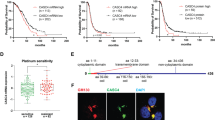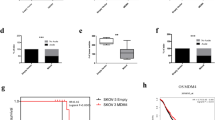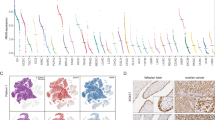Abstract
High-grade serous ovarian cancer is an aggressive form of epithelial ovarian cancer (EOC), and accounts for the majority of deaths due to EOC. The critical cellular processes and underlying molecular mechanisms that define this malignancy remain poorly understood. Using a syngeneic murine model, we investigated the changes that accompanied the progression to increased aggressiveness induced by in vivo passage of mouse EOC cells. We found that enhanced anoikis resistance was a key cellular process associated with greater aggressiveness and tumorigenicity in vivo. Biochemical studies revealed that the enhanced anoikis resistance was associated with the activation of the Src/Akt/Erk signaling pathway. A higher rate of metabolism and autophagy were also associated with increased anoikis resistance. Blocking these pathways with specific inhibitors and/or genetic modifications significantly increased anoikis in vitro and inhibited tumor development in vivo. In addition, we demonstrated that similar signaling pathways were also involved in a human EOC cell line model. Collectively, our data suggest that anoikis resistance represents a critical and a distinguishing feature underlying the aggressiveness of ovarian cancer cells.
This is a preview of subscription content, access via your institution
Access options
Subscribe to this journal
Receive 50 print issues and online access
$259.00 per year
only $5.18 per issue
Buy this article
- Purchase on Springer Link
- Instant access to full article PDF
Prices may be subject to local taxes which are calculated during checkout








Similar content being viewed by others
References
Cancer Genome Atlas Research Network, Integrated genomic analyses of ovarian carcinoma. Nature 2011; 474: 609–615.
Janat-Amsbury MM, Yockman JW, Anderson ML, Kieback DG, Kim SW Combination of local, non-viral IL12 gene therapy and systemic paclitaxel chemotherapy in a syngeneic ID8 mouse model for human ovarian cancer. Anticancer Res 2006; 26: 3223–3228.
Said NA, Najwer I, Socha MJ, Fulton DJ, Mok SC, Motamed K SPARC inhibits LPA-mediated mesothelial-ovarian cancer cell crosstalk. Neoplasia 2007; 9: 23–35.
Roby KF, Taylor CC, Sweetwood JP, Cheng Y, Pace JL, Tawfik O et al. Development of a syngeneic mouse model for events related to ovarian cancer. Carcinogenesis 2000; 21: 585–591.
Sher I, Adham SA, Petrik J, Coomber BL Autocrine VEGF-A/KDR loop protects epithelial ovarian carcinoma cells from anoikis. Int J Cancer 2009; 124: 553–561.
Chiarugi P, Giannoni E . Anoikis: a necessary death program for anchorage-dependent cells. Biochem Pharmacol 2008; 76: 1352–1364.
Guadamillas MC, Cerezo A, Del Pozo MA Overcoming anoikis-pathways to anchorage-independent growth in cancer. J Cell Sci 2011; 124: 3189–3197.
Schafer ZT, Grassian AR, Song L, Jiang Z, Gerhart-Hines Z, Irie HY et al. Antioxidant and oncogene rescue of metabolic defects caused by loss of matrix attachment. Nature 2009; 461: 109–113.
Ward PS, Thompson CB Metabolic reprogramming: a cancer hallmark even warburg did not anticipate. Cancer Cell 2012; 21: 297–308.
Miskimins WK, Ahn HJ, Kim JY, Ryu S, Jung YS, Choi JY Synergistic anti-cancer effect of phenformin and oxamate. PLoS ONE 2014; 9: e85576.
Yu D, Wolf JK, Scanlon M, Price JE, Hung MC Enhanced c-erbB-2/neu expression in human ovarian cancer cells correlates with more severe malignancy that can be suppressed by E1A. Cancer Res 1993; 53: 891–898.
Baumal R, Law J, Buick RN, Kahn H, Yeger H, Sheldon K et al. Monoclonal antibodies to an epithelial ovarian adenocarcinoma: distinctive reactivity with xenografts of the original tumor and a cultured cell line. Cancer Res 1986; 46: 3994–4000.
Ahmed N, Stenvers KL Getting to know ovarian cancer ascites: opportunities for targeted therapy-based translational research. Front Oncol 2013; 3: 256.
Ward KK, Tancioni I, Lawson C, Miller NL, Jean C, Chen XL et al. Inhibition of focal adhesion kinase (FAK) activity prevents anchorage-independent ovarian carcinoma cell growth and tumor progression. Clin Exp Metastasis 2013; 30: 579–594.
Li H, Wang D, Zhang H, Kirmani K, Zhao Z, Steinmetz R et al. Lysophosphatidic acid stimulates cell migration, invasion, and colony formation as well as tumorigenesis/metastasis of mouse ovarian cancer in immunocompetent mice. Mol Cancer Ther 2009; 8: 1692–1701.
Acknowledgements
We thank Caryl Antalis and Christy A Tidwell for their critical reading and editing of this manuscript. This work is supported in part by the National Institutes of Health (RO1 155145 to YX) and the Mary Fendrich-Hulman Charitable Trust Fund to YX.
Author information
Authors and Affiliations
Corresponding author
Ethics declarations
Competing interests
The authors declare no conflict of interest.
Rights and permissions
About this article
Cite this article
Cai, Q., Yan, L. & Xu, Y. Anoikis resistance is a critical feature of highly aggressive ovarian cancer cells. Oncogene 34, 3315–3324 (2015). https://doi.org/10.1038/onc.2014.264
Received:
Revised:
Accepted:
Published:
Issue Date:
DOI: https://doi.org/10.1038/onc.2014.264
This article is cited by
-
Tumor microenvironment in ovarian cancer peritoneal metastasis
Cancer Cell International (2023)
-
Anoikis resistance and immune escape mediated by Epstein-Barr virus-encoded latent membrane protein 1-induced stabilization of PGC-1α promotes invasion and metastasis of nasopharyngeal carcinoma
Journal of Experimental & Clinical Cancer Research (2023)
-
Impact of context-dependent autophagy states on tumor progression
Nature Cancer (2023)
-
ACSL1-induced ferroptosis and platinum resistance in ovarian cancer by increasing FSP1 N-myristylation and stability
Cell Death Discovery (2023)
-
Visfatin induces ovarian cancer resistance to anoikis by regulating mitochondrial activity
Endocrine (2023)



